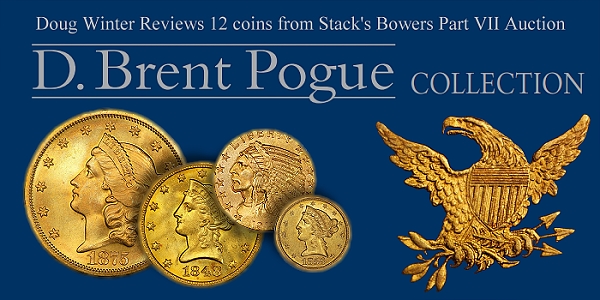
The Pogue VII Sale by Doug Winter – RareGoldCoins.com …… CoinWeek Content Partner
You couldn’t have picked a more dire set of circumstances faced by Stack’s Bowers for their various March coin and paper money auctions.
After the Covid-19 virus cancelled the Baltimore coin show, the firm grappled with the difficult questions forced by the crazy and rapidly-getting-crazier events of 2019. To cancel or not to cancel, that was the question.
Possessed with cojones the size of California, the decision was made to move the sale to the West Coast. When I heard this news I was pretty amazed but I totally understood Stack’s Bowers’ positon: they were financially committed and with things likely to get worse in the coming weeks, it ultimately made sense to go ahead and sell the coins.
My assumption was that the Pogue VII Sale would do well no matter the circumstances. The coins were absolutely amazing and there weren’t that many of them. Given the wealth of the Pogue family and the circumstances associated with the collection, it seemed unlikely to me that the family would make the decision to postpone the sale.
As I write this recap the day after the sale, I am amazed at a number of things.
First of all, I am amazed at the scope of the participation. I’m in self-quarantine (and have been for close to two weeks) so I wasn’t going to attend live (I participated by internet and phone bidding but this is no different from how I’ve approached auctions for at least five years), but the Fear of Gatherings didn’t keep dealers from viewing and bidding live.
Second, while I’m not surprised by the prices realized, I am amazed by them. It takes guts to spend $2,500, $25,000 or even $250,000 USD on a coin after collectors have been dealt a world of hurt by the economic impact of the last few weeks. Kudos to the collectors who saw the opportunity to buy once-in-a-generation coins and overcame the fear we are all feeling right now.
So, you ask, how did the sale do? Coins under $10,000 were exceptionally strong. Coins in the $10,000-50,000 range mostly did very well. The only area of weakness in the sale was the ultra-expensive coins, although there were some very expensive coins which did really well.
Here are a dozen rare gold coins from the sale along with my perspectives and what the prices realized mean in today’s ultra-volatile market.
Pogue VII Sale Lot 7321: PCGS/CAC MS67+ 1855 Gold Dollar
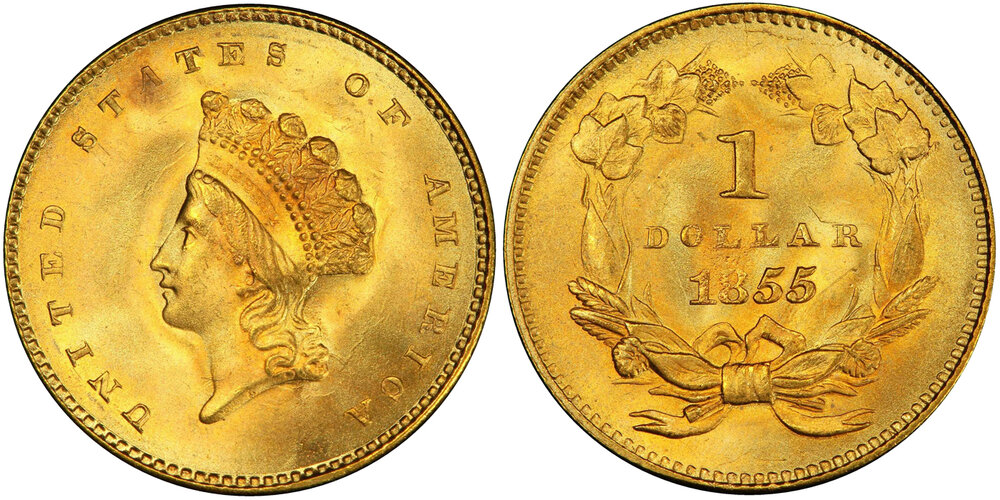
Lot 7321. Images courtesy Stack’s Bowers Galleries
For collectors old enough to remember 12-piece US gold type sets, Gem Type Two gold dollars are important and rare issues. But this type has lost considerable importance in recent years due to gradeflation, the rise of collecting by denomination, and the fact that people like big coins more than small coins.
The Pogue 1855 Type Two was the best example of this date I have ever seen and it was the second-finest Type Two, in my opinion, trailing only the amazing Eliasberg 1854 (which last sold, as an NGC MS68, for $126,500 in 2002). The Pogue coin was obtained in November 2007 for $97,750.
The coin was estimated at $90,000-110,000, which I thought was accurate. It sold for $120,000 (please note that all sales prices in this article include the buyer’s premium, except where noted), which I thought was a decent but not exceptional price. It showed minimal appreciation in the 12+ years it was held by the Pogue family, and this is attributable to the type having lost much of its appeal, as I stated above.
Pogue VII Lot 7324: PCGS/CAC PR64 CAMEO 1841 Quarter Eagle
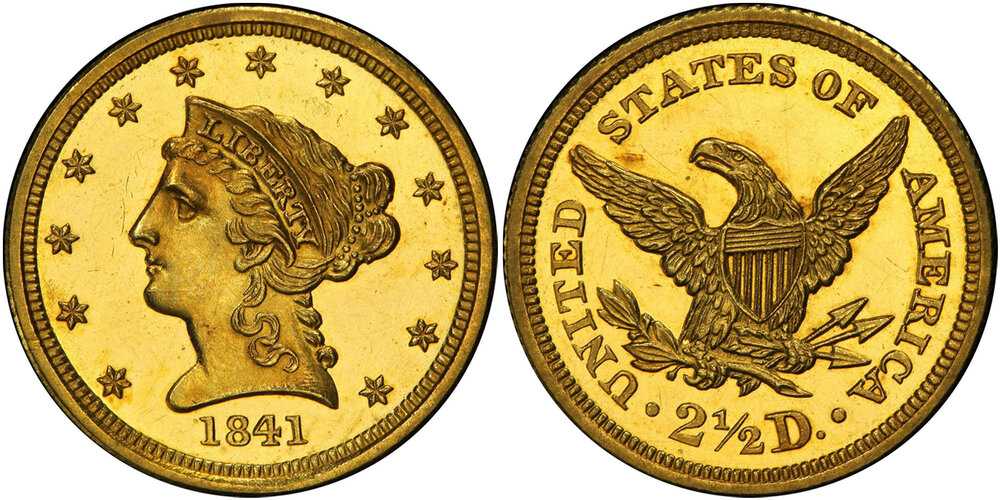
Lot 7324
The 1841 quarter eagle is a controversial issue. Some experts (including me) believe that examples are known in both business strike and Proof format; others feel that this is a Proof-only issue. The Pogue coin is the clear finest known and it is one of just three Proofs known (outside of museums) that aren’t impaired. This wasn’t the best known coin in the sale, but it was among the rarest.
The Pogue coin was superb. I had first seen it in the Bass III sale (May 2000) and I might have purchased it for the Kansas Collection of quarter eagles (the finest set of quarter eagles ever assembled and a project that has been 25+ years in the making) had this collector not bought the PCGS PR60 in Bass II, held the year before. Brent Pogue paid $178,250 for it and the record price for an 1841 quarter eagle was set in June 2004, when Heritage sold an example graded PF65 by NGC for $253,000.
The coin sold for $408,000. This is a record price for the date and it is, to the best of my knowledge, an auction record for any quarter eagle, beating the previous record of $402,500 set by the finest known 1848 CAL, graded MS68★ by NGC, that sold in the January 2006 Heritage FUN auction.
I regard this as an extremely strong price; at least 20% more than what I expected prior to the sale.
Pogue VII Lot 7325: PCGS AU50 1854-S Quarter Eagle
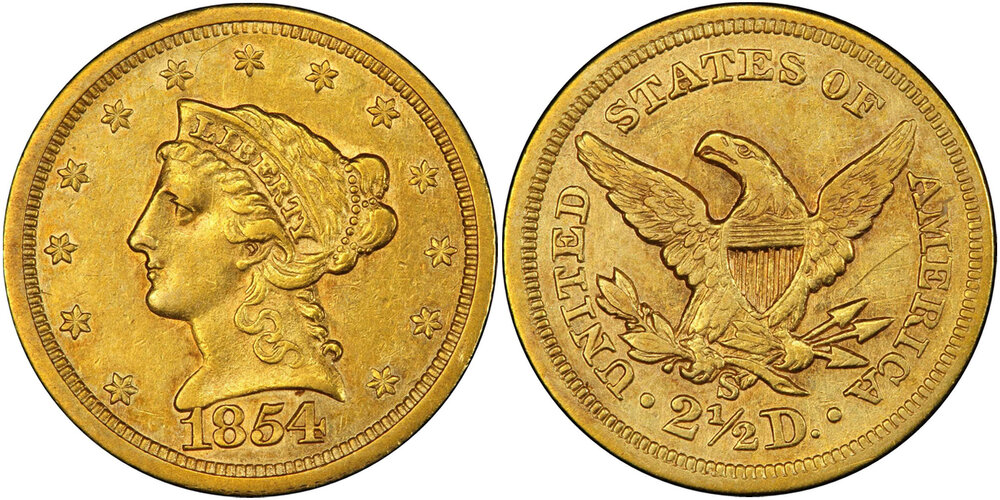
Lot 7325
While overshadowed by the half eagle of this date, the 1854-S quarter eagle is the rarest Liberty Head quarter eagle. I’ve been a one-man hype machine for this issue since the 1980s and the Pogue coin is regarded as the finest known. It sold for $135,700 in October 1999 as part of the Bass Collection, and it was obtained by Brent Pogue in January 2004 for $178,250.
This was one of the few coins in the Pogue Sale that I didn’t especially like from a quality standpoint. But it’s an 1854-S, and there are only two or three nice examples of this date. I had remembered it as a very solid AU50 (If I recall, it had been graded AU53 by NGC at one time) but my 2020 Coin Eyes saw this example more as an EF45 with a reverse scratch. But don’t get me wrong… it’s a whale of a coin.
The final price realized was $384,000, which was a record price for the date. I regard this as an extremely strong price for a coin that while truly rare is esoteric and well-circulated.
Pogue VII Lot 7334: PCGS/CAC MS65 1845-D Half Eagle
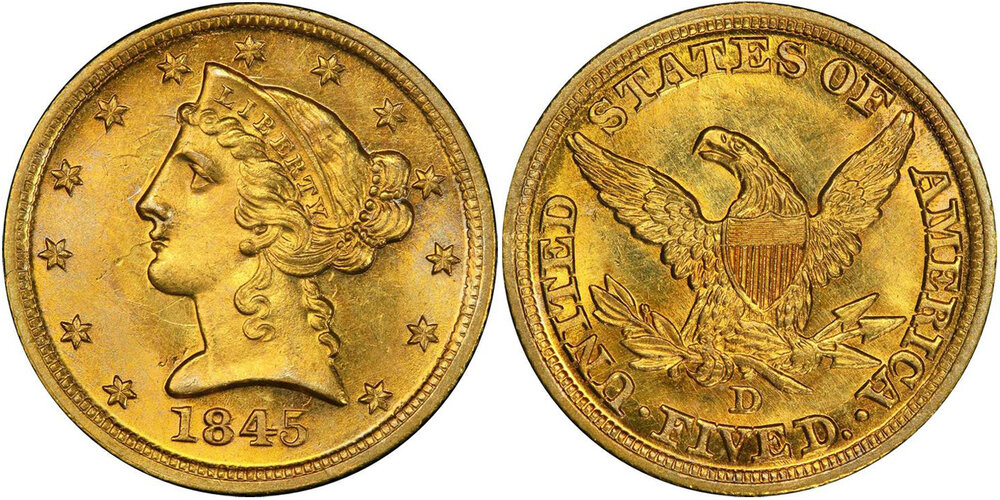
Lot 7334
The Pogue Collection contained only a single Dahlonega coin, but what a coin it was: a Gem 1845-D half eagle with a pedigree including Norweb, Bass, and yours truly. This is one of just four Dahlonega half eagles of any date graded MS65 by PCGS and it is the only piece likely to be available for some time.
This coin had last sold for $80,500 in August 2006, which I regarded as an extremely strong price at the time; I had paid $47,500 for it in partnership with another dealer in 2003 and I then sold it to a West Coast collector.
The coin sold for $96,000 at Pogue VII, which I regard as a very strong price; I felt the coin was going to bring around $70,000. The fact that it was the only CAC-approved Dahlonega half eagle in MS65 (with none finer) gave it a broad sense of demand.
Lot 7335: PCGS/CAC AU58+ 1854-S Half Eagle
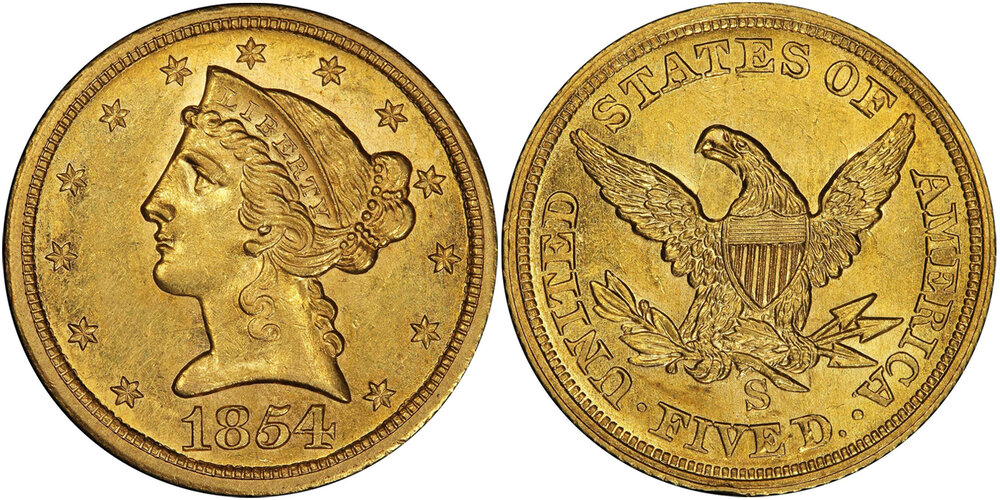
Lot 7335
This was the Big Coin in the sale; the piece everyone had an opinion on.
As recently as a few weeks ago, if you’d asked me the value of this coin, I’d have said in excess of $3 million. The sale of the lower-grade example (formerly NGC EF45 and now PCGS EF45) for in excess of $2.16 million set the bar for the Pogue coin. Or so we thought…
There was a lot to love about the 1854-S half eagle. It is the finest known of only three pieces with one impounded in the Smithsonian. The pedigree was great, and the Pogue family had purchased it in the Eliasberg sale (October 1982) for $187,000. The PCGS grade was spot-on, and the coin looked just wonderful in the holder.
Those of us who follow the upper-end of the dated gold market knew that Dell Loy Hansen would be a player for the coin, but the Big Question was who else–if anyone–would bid. Two weeks ago, I could have thought of two or three possible buyers, including a client of mine with whom I had a long discussion about it.
The sale proved to be a bit of a letdown for those of us watching at home. The coin opened at $1,500,000 and after a drawn-out plea for bids by the auctioneer, it sold for $1,600,000 hammer – or $1,920,000 with the buyer’s premium.
This was the best buy of the sale and maybe the best buy of any ultra-rarity since the Great Recession of 2008-9. My sincere congratulations to Hansen for this wise purchase, and to have the guts to spend nearly $2 million on a coin when no one else would.
Pogue VII Sale Lots 7337: PCGS/CAC MS66 1911-S Half Eagle and 7345: PCGS/CAC, MS68 1908-D Motto Eagle

Lot 7337
I’m lumping these two coins together because they are closely related. Both are likely the finest known for their respective issues. Both were absolutely superb coins. Both are classic condition rarities (available in lower Mint State grades but very rare in Gem). And both were members of series that have few specialists working on Gem sets in 2020.
The 1911-S had a great pedigree as it was ex: Col. Green, King Farouk and John Pittman. It had last sold in October 1997 where it brought a record price for the date at $66,000. 23 years later it sold for $79,200.
I consider this price to be a little soft considering the significance of this coin, but one needs to understand that there are currently no major buyers of Indian Head half eagles. If there had been two strong collectors bumping heads on this great coin, it could have easily sold for $125,000+.
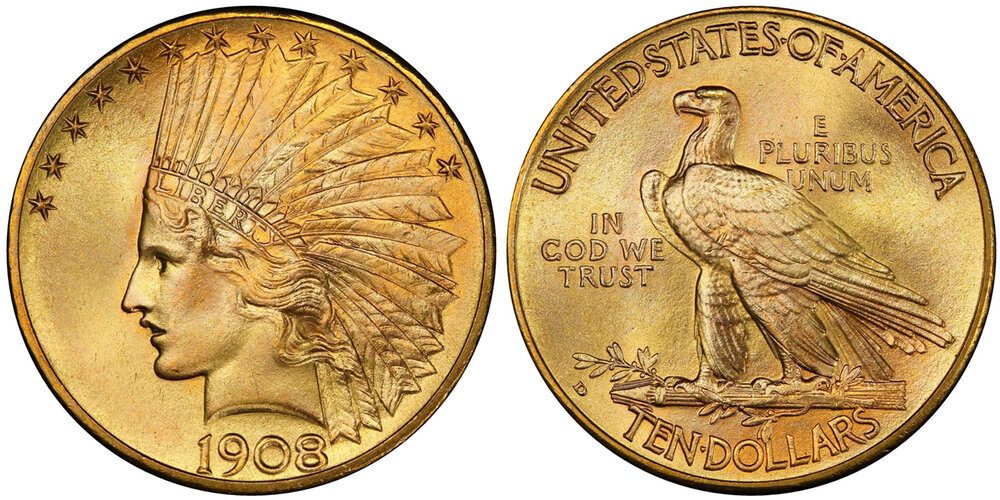
Lot 7345
The 1908-D Motto was a famous coin with a Clapp/Eliasberg/Duckor/Pogue pedigree. It had been obtained by John Clapp, Sr. directly from the Mint at the time of issue and even though there is another coin of this date graded MS68 by PCGS, it is easily the finest known.
Brent Pogue purchased this coin for $230,000 in 2006 and it was estimated at $200,000-300,000. Given that the Simpson Collection already contained the other PCGS MS68, I figured this coin might sell reasonably.
The coin sold for $204,000, which I think is a real bargain. As with the 1911-S half eagle, if there had been two deep-pocketed collectors knocking heads, it could have easily broken the $300,000 barrier.
Lot 7338: PCGS/CAC MS66 1848-O Eagle
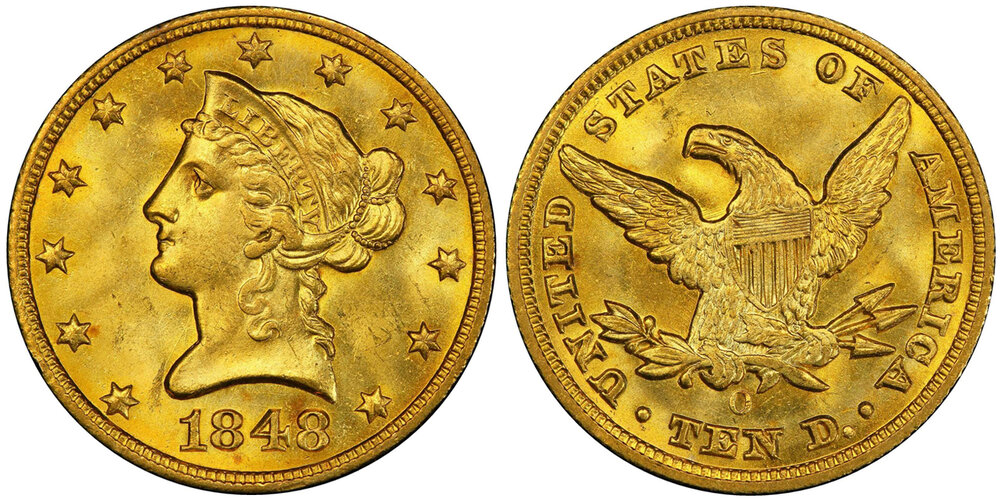
Lot 7338
I’ve been in love with this coin since I first saw it, raw, in the James Stack Sr. sale held back in 1994 when it brought $154,000. It’s the single-finest No Motto New Orleans eagle in existence and it is one of the two best No Motto eagles of any date (the other, dated 1852 and graded MS66+ by PCGS/CAC, was also in the sale and I purchased it for $288,000).
The owner of the New England Collection of New Orleans gold coinage has wanted this coin for many years and when we learned it was going to be offered in the Pogue sale, he was excited. We had a number of discussions about what the right price was for the coin and who would be the likely competition.
I purchased the coin for $240,000 – which I believe was well under market value. The fact that the Tyrant Collection contained a nice PCGS/CAC MS64 likely saved me $100,000+.
Lots 7348: PCGS MS66 1869 and 7349: PCGS/CAC MS67 1875-S Double Eagles
These two coins are closely related and I feel it makes sense to discuss them jointly.
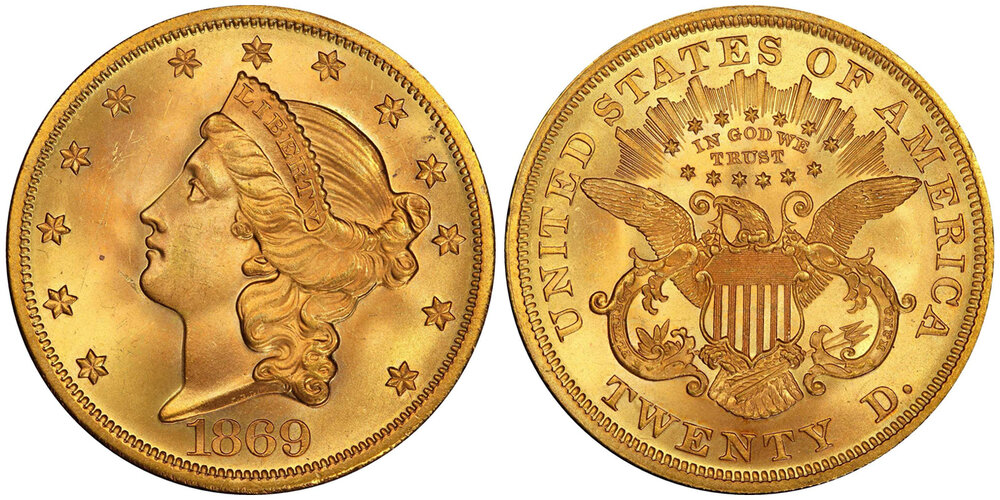
Lot 7348
The 1869 was aesthetically dazzling, but I felt it was just a hair over-graded as an MS66 due to the presence of a hairline in the left obverse field. It had twice sold as a PCGS MS65 (for $218,500 in January 2005 and again in January 2008 for $299,000; this time to Brent Pogue). It didn’t sticker at CAC and likely would have as a PCGS MS65+.
Buyers of Liberty Head double eagles are spooked right now by the glut of coins in the market, mostly from overseas. But they don’t realize that there are absolutely no Gems coming from these sources.
This coin brought $204,000, which I regard as a fairly disappointing result. Had it been CAC-approved as a PCGS MS66, it likely would have brought close to its low estimate of $300,000-400,000. I expected it to bring more in the $250,000-275,000 range.
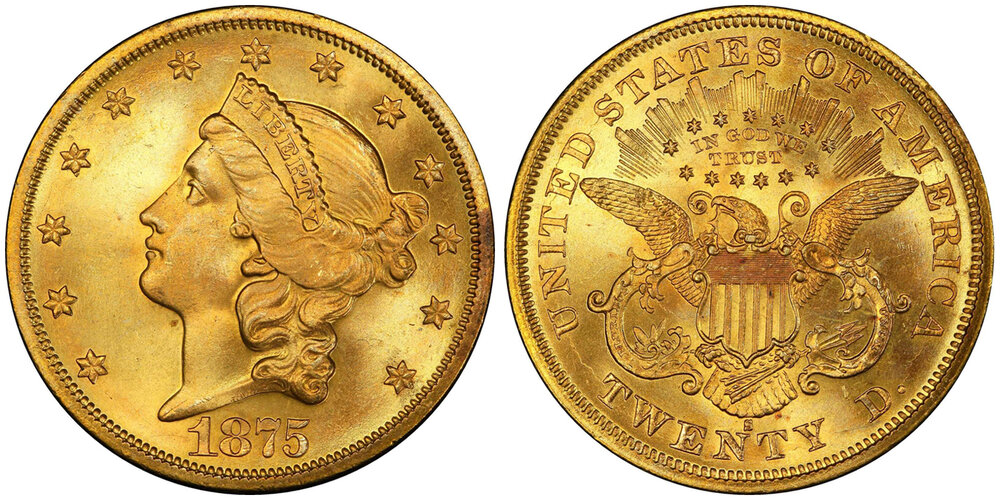
Lot 7349
And then there was the famous James Stack 1875-S, which I regard as the single-finest Liberty Head double eagle in existence.
This coin brought $82,500–raw–back in March 1995, long before Liberty Head double eagles became avidly collected by date. Brent Pogue paid $575,000 for it via private treaty in 2009.
The coin opened at $360,000 and I was stunned that it received no other bids. Not even a cut. The final price of $432,000 was a record at auction for a business strike Type Two double eagle, breaking the previous high of $414,000 set by an NGC AU55 1870-CC in March 2009 and by an NGC MS64 1871-CC in April 2008 (it should be noted that at least two or three higher prices have been set by private treaty sales of 1870-CC double eagles).
Lot 7352: PCGS/CAC MS68+ Flat Rim High Relief
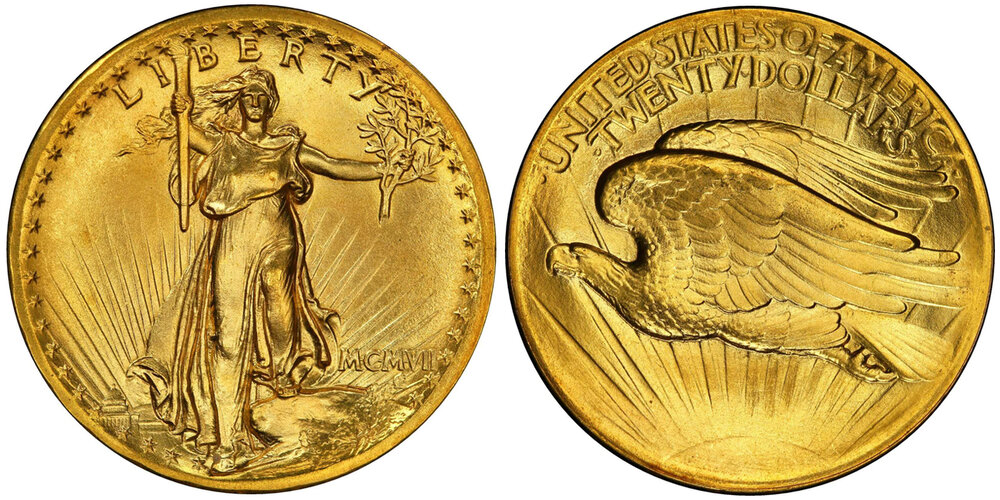
Lot 7352
I’ve seen my share of Superb Gem High Relief double eagles but I can’t recall having liked one more than this, the former Morse: 6527 that sold for $264,500 in November 2005 and again in January 2007 (to Brent Pogue) at $316,250. The coin was nearly perfect and it had gorgeous glowing yellow-gold color.
The coin sold for $456,000, which isn’t a record for a business strike High Relief but I think it’s a strong price given that the market is currently flooded with High Reliefs (granted, not of this quality). I expected the price to be more in the $350,000-400,000 range.
Lot 7355: PCGS/CAC MS67 1927-S Double Eagle
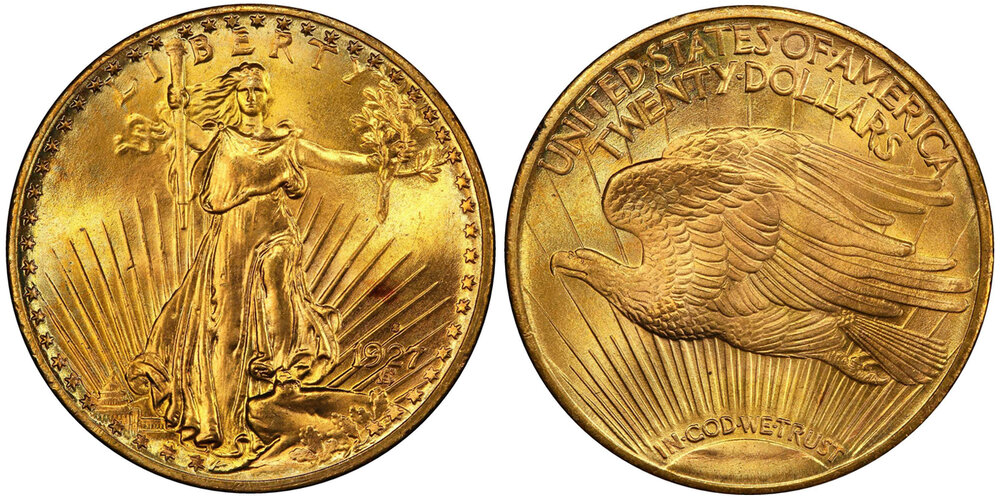
Lot 7355
This is my single-favorite St. Gaudens double eagle. It’s a spectacular coin for the date and grade and clearly the single-finest 1927-S. It has a great pedigree (Godard/Morse/Duckor/Pogue) and it can be traced back to the date of issue.
The Fox: 4047 coin (graded MS66+ by PCGS/CAC) had just sold for $312,000 in January and, in my opinion, the Pogue coin was finer. Brent Pogue purchased it in 2013 for $340,750 and it had sold in the 2005 Morse auction for a record-setting $345,000.
Curiously, this coin was estimated at “only” $150,000-200,000 and this may be the reason it sold for a reasonable $264,000. With Rollo Fox out of the dated Saint market, there are no new buyers taking his place (yet) and the new owner was able to purchase this coin for what I think was a real bargain.
Looking back at these prices, I think there were some excellent values for foresighted collectors. But we have to remember the economic panic felt throughout the world all through March 2020. It took a lot of courage to buy an 1869 double eagle for $204,000, or a Proof 1841 quarter eagle for $408,000 at the Pogue sale and it will be interesting to look back at these prices in five years and analyze if they were prudent purchases or if the market dipped much further. Collectors realized that coins like this are world-class and rarely offered and, in most cases, they stepped-up and paid strong prices for them.
If you have comments or questions about this sale, please feel free to contact me via email at [email protected].
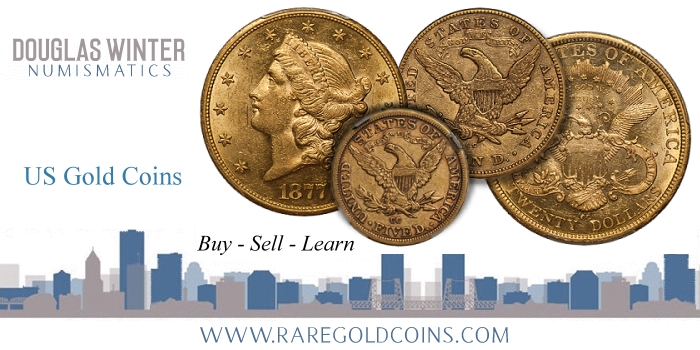
* * *
About Doug Winter
 Doug has spent much of his life in the field of numismatics; beginning collecting coins at the age of seven, and by the time he was 10 years old, buying and selling coins at conventions in the New York City area.
Doug has spent much of his life in the field of numismatics; beginning collecting coins at the age of seven, and by the time he was 10 years old, buying and selling coins at conventions in the New York City area.
In 1989, he founded Douglas Winter Numismatics, and his firm specializes in buying and selling choice and rare US Gold coins, especially US gold coins and all branch mint material.
Recognized as one of the leading specialized numismatic firms, Doug is an award-winning author of over a dozen numismatic books and the recognized expert on US Gold. His knowledge and an exceptional eye for properly graded and original coins have made him one of the most respected figures in the numismatic community and a sought after dealer by collectors and investors looking for professional personalized service, a select inventory of impeccable quality and fair and honest pricing. Doug is also a major buyer of all US coins and is always looking to purchase collections both large and small. He can be reached at (214) 675-9897.
Doug has been a contributor to the Guidebook of United States Coins (also known as the “Redbook”) since 1983, Walter Breen’s Encyclopedia of United States and Colonial Coins, Q. David Bowers’ Encyclopedia of United States Silver Dollars and Andrew Pollock’s United States Pattern and Related Issues
In addition, he has authored 13 books on US Gold coins including:
- Gold Coins of the New Orleans Mint: 1839-1909
- Gold Coins of the Carson City Mint: 1870 – 1893
- Gold Coins of the Charlotte Mint: 1838-1861
- Gold Coins of the Dahlonega Mint 1838-1861
- The United States $3 Gold Pieces 1854-1889
- Carson City Gold Coinage 1870-1893: A Rarity and Condition Census Update
- An Insider’s Guide to Collecting Type One Double Eagles
- The Connoisseur’s Guide to United States Gold Coins
- A Collector’s Guide To Indian Head Quarter Eagles
- The Acadiana Collection of New Orleans Coinage
- Type Three Double Eagles, 1877-1907: A Numismatic History and Analysis
- Gold Coins of the Dahlonega Mint, 1838-1861: A Numismatic History and Analysis
- Type Two Double Eagles, 1866-1876: A Numismatic History and Analysis
Finally, Doug is a member of virtually every major numismatic organization, professional trade group and major coin association in the US.




